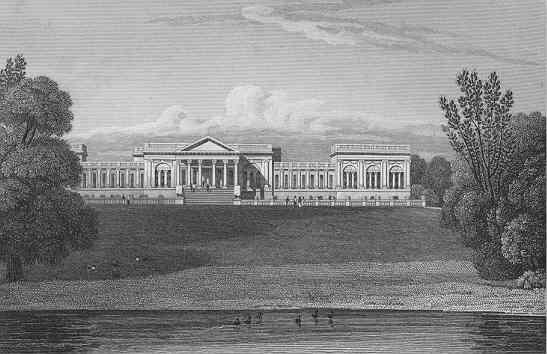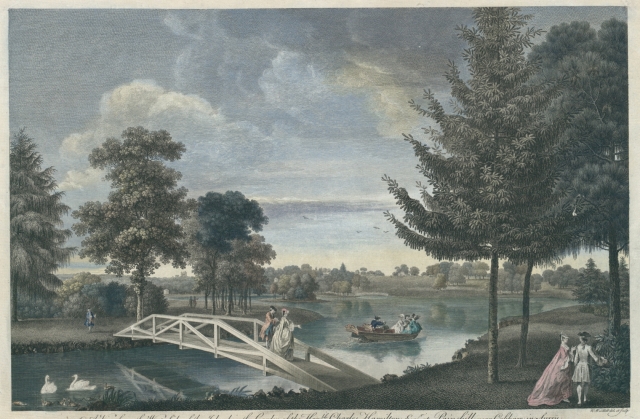We are thrilled to welcome author Claire Cock-Starkey to our blog today to share with us some fascinating information about eighteenth-century gardens, as her latest book, The Golden Age of the Garden is released today by publishers Elliott & Thompson.
During the Georgian period a new style of garden superseded the Renaissance formal garden. Gone were the parterres, the neatly trimmed box hedges and the geometric gravel pathways, and in their stead came the naturalistic styles of the landscape design movement – inspired by the English pastoral ideal.
The landscape design movement held nature as its guide – using serpentine paths to meander past organic bodies of water, to picturesque ruined follies and through artfully placed groves of trees. These gardens were designed to provide fresh vistas at every turn, with variety and contrast used to ensure the visitor was constantly delighted by the changing landscape.
The most famous gardeners of the era included William Kent, Lancelot ‘Capability’ Brown and Humphry Repton, all of whom contributed a great deal to what today we still consider some of the finest gardens in the land. Let us take a little tour through some of the iconic gardens of the Georgian era, with some contemporary descriptions:

Stowe
Stowe gardens in Oxfordshire were one of the most famed gardens of the Georgian era. From 1713 Viscount Cobham employed architect John Vanbrugh and gardener Charles Bridgeman to begin modelling the grounds, later also engaging William Kent and Capability Brown to continue improvements.
‘Here is such a scene of Magnificence and Nature display’d at one View. To the Right you have a View of the Gothic Temple, Lord COBHAM’s Pillar, and the Bridge; in the Center is a grand View of the House, and on the Left the Piramid; the Trees and Water so delightfully intermingled, and such charming Verdure, symmetry, and Proportion every where presenting to the Eye, that the Judgment is agreeably puzzled, which singularly to prefer, of so many Beauties.’ – The Beauties of Stow by George Bickham (1753)

Blenheim
Also designed by prominent architect Sir John Vanbrugh, Blenheim Palace was built between 1705 and 1733. The large grounds were extensively remodelled by Capability Brown between 1764 and 1774.
‘All this scenery before the castle, is now new-modelled by the late ingenious Mr. Brown, who has given a specimen of his art, in a nobler style, then he has commonly displayed. His works are generally pleasing; but here they are great. About a mile below the house, he has thrown across the valley, a massy head; which forms the rivulet into a noble lake, divided by the bridge, (which now appears properly with all the grandeur of accompaniments) into two very extensive pieces of water. Brown himself used to say, “that the Thames would never forgive him, what he had done at Blenheim.” And every spectator must allow, that. On entering the great gate from Woodstock, the whole of this scenery, (the castle, the lawn, the woods, and the lake) seen together, makes one of the grandest bursts, which art perhaps ever displayed.’ – Observations on the Mountains and Lakes of Cumberland and Westmoreland by William Gilpin (1786).

Painshill
The gardens of Painshill near Cobham in Surrey were designed by their owner the Honourable Charles Hamilton and laid out 1738–73.
‘But Painshill is all a new creation; and a boldness of design, and a happiness of execution, attend the wonderful efforts which art has there made to rival nature. An easy winding descent leads from the Gothic building to the lake, and a broad walk is afterwards continued along the banks, and across an island, close to the water on one hand, and skirted by wood on the other: the spot is perfectly retired; but the retirement is cheerful; the lake is calm; but it is full to the brim, and never darkened with shadow; the walk is smooth, and almost level, and touches the very margin of the water; the wood which secludes all view into the country, is composed of the most elegant trees, full of the lightest greens, and bordered with shrubs and with flowers; and though the place is almost surrounded with plantations, yet within itself is open and airy; it is embellished with three bridges, a ruined arch, and a grotto; and the Gothic building, still very near, and impending directly over the lake, belongs to the place; but these objects are never visible all together; they appear in succession as the walk proceeds; and their number does not croud the scene which is enriched by their frequency.’ – Observations on Modern Gardening by Thomas Whately (1770).

The Leasowes
The poet William Shenstone created the gardens at the Leasowes between 1743 and 1763. Shenstone intended to create a ferme ornée – an ornamented farm which combines practicality and beauty and his achievements at the Leasowes were much admired by contemporary visitors.
‘The moment I entered this quiet and sequestered valley, the superlative genius of Shenstone stood confessed on every object, and struck me with silent admiration. – I turned to a bench under the wall, and sat so absorbed, with the charms of a cascade, so powerfully conducted in the very image of nature herself, plunging down a bed of shelving rock, and huge massy stones, that, for a long while, my attention was lost to every thing else – I strove to find out where the hand of the designer had been, but could not: – surely nothing was ever held to the eye so incomparably well executed! And if we add to its analogous accompaniments, of bold scarry grounds, rough entangled thicket, clustering trees, and sudden declivities: I cannot but be persuaded, it is altogether one of the most distinguished scenes that ever was formed by art.’ – Letters on the Beauties of Hagley, Envil, and the Leasowes by Joseph Heely (1777).

Chatsworth
In 1760 Capability Brown took out the old formal gardens and converted much of the farmland into parkland at Chatsworth in Derbyshire, substantially altering the grounds. Brown utilised many of his signature designs, such as rolling parkland, belts of trees to enclose the view and an expanse of water to reflect the vistas.
‘This extensive part presents a great variety of aspect, from the most graceful undulating hill and swelling eminence, interspersed with plantations, beautiful lawns and pleasure grounds to the bold rugged cliff and lofty mountain, well watered and richly wooded, including an area of about 11 miles in circumference, stocked with about two thousand head of deer, sheep and cattle in vast numbers, and kept in the finest possible order.
. . .
On a fine sunny day it is truly sublime, and it need scarcely be observed that we stood for a while to contemplate a scene so enchanting – a scene which a century ago could not have been dreamed of as likely to exist amongst healthy mountains and the wilds of the Peak. But it exhibits a splendid specimen of the enrichment of art, and the capability of a world, however sterile and forbidding in its natural aspect, of being converted, by persevering industry and judicious management, into a very Paradise.’ – Description of Buxton, Chatsworth and Castleton by William Adam (1847).
Featured Image:
View of Chatsworth Looking across the Lake, British School, Government Art Collection

on my birthday wishlis
LikeLiked by 3 people
I’ll be buying this book for sure, very interesting! I hope there’s a discussion about the follies that were so popular and the various ‘hermits’ etc that were hired to inhabit them. It would also be good if there’s information about the garden of the notorious Sir Francis Dashwood, which I understand once made a priest pass out from shock…
LikeLiked by 1 person
Thanks for your lovely comments! There are indeed some extracts concerning follies and melancholy places for contemplation. Unfortunately no ornamental hermits in this book but by coincidence I have just written an article on ornamental hermits for Mental Floss which should be up soon. I really hope you’ll enjoy the book.
LikeLiked by 1 person
Reblogged this on Lenora's Culture Center and Foray into History.
LikeLiked by 2 people
Pingback: International Responses to the English Landscape Garden - Geri Walton
Pingback: Guest blogging for the Golden Age of the Garden